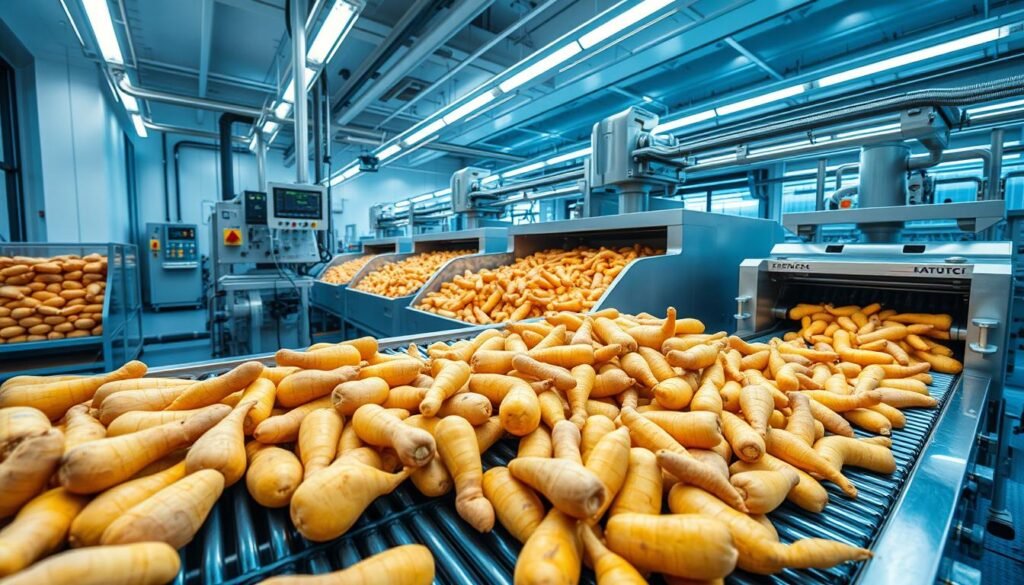Ever thought about how yams, an ancient food, are being updated by new tech? The yam processing world is changing fast, focusing on being better for our planet and our health. Nigeria is the top yam producer, making up 66% of the world’s yams. We’re diving into yam’s history and today’s tech advancements.
With more people caring about their health, new ways to process yams are key. This includes making yam flour and using new techniques in our food. These changes are important for what we eat every day.
Key Takeaways
- Yam is a vital food crop with high global demand.
- Nigeria leads worldwide yam production, contributing significantly to food security.
- Modern yam processing technologies enhance efficiency and nutritional value.
- Yams offer various health benefits, being a source of carbohydrates and protein.
- Sustainable practices in processing can minimise environmental impact.
- Innovative machinery, like the Li An Root Veg Washing Peeling machine, boosts processing capabilities.
Introduction to Yam Processing Technologies
The journey of yam processing technologies has seen big changes. We’ve moved from old ways to new ones, thanks to the need for healthy yam products. This change shows how people now know yams are good for us, full of vitamins and minerals.
The yam extract industry is really interesting. New yam processing technology makes products better and safer. For example, drying and blanching are now done in a way that keeps yams tasty and healthy.
Old ways of making food, especially in West Africa, face big challenges. Slow progress leads to food and nutrition problems. But, new methods like extrusion cooking make yams easier to digest for more people, even those in Europe and North America.
Studies show yams are very nutritious. For instance, “poundo” yam has lots of carbs, protein, and fat. This makes yams a great food choice.
We keep working on yam processing to make it better. We want to improve taste, convenience, and make it sustainable and healthy. Looking ahead, new yam processing tech will bring many healthy options for us all.
The Importance of Yams in Global Cuisine
Yams are a big deal in many cultures, especially in Africa, the Caribbean, and Asia. They’re versatile and key in traditional dishes. In 2018, Africa produced 96.2% of the world’s yams, with Nigeria leading at 65.9%.
Yams are more than food; they’re part of cultural and social life. They’re celebrated in ceremonies and festivals, showing their importance. This highlights the traditions and beliefs tied to yam cultivation, bringing communities together.
Yams are also good for you, packed with carbs, vitamins, and minerals. People worldwide eat about 18 million tons of yams each year. In West Africa, folks eat an average of 61 kg of yams per person. This shows how yams help fight malnutrition and food insecurity.
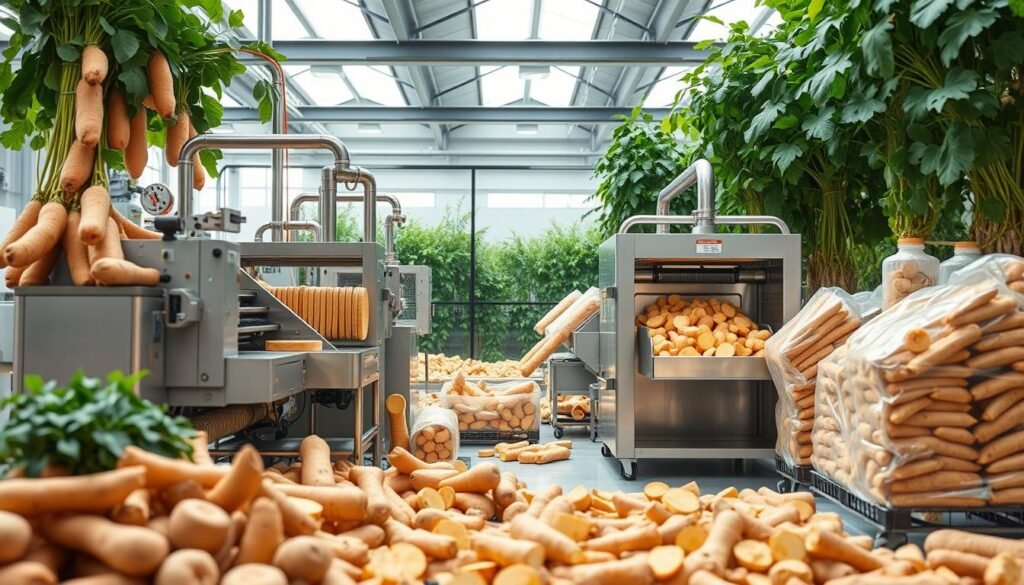
Research shows yams have health benefits thanks to their bioactive compounds. They help boost health with their antioxidants and immune system support. The right processing technology can keep these nutrients high while reducing harmful compounds.
Looking into yam varieties and uses, we see their cultural, nutritional, and economic value. This understanding shows the importance of yams and the need for good processing technology. It keeps yams relevant in today’s food world.
Understanding Yam Varieties and Their Uses
Yams are a key food for millions, especially in West Africa. They come in many species, each with its own uses. Learning about yam health benefits shows why they’re great for our diets.
Key Edible Varieties of Yam
Dioscorea rotundata, or white yam, is loved for its creamy texture and taste. Dioscorea alata, or water yam, is known for its purple skin and white flesh, often used in soups.
Other yam varieties include:
- Dioscorea esculenta – Known as lesser yam, it’s sweeter and used in many dishes.
- Dioscorea bulbifera – Called air yam; it has aerial tubers and is used in both sweet and savoury dishes.
In West Africa, yams are a big part of the diet. They’re a rich source of calories and nutrients. In countries like Nigeria and Ghana, yams are a key part of daily meals.
Health Benefits of Yams
Yams are not just food; they’re also good for health. They’re high in fibre, which helps with digestion and regular bowel movements. They also have vitamin C and potassium, which boost the immune system and heart health.
Yams also have inulin, which is good for the stomach and may prevent diabetes. Antioxidants in yams fight oxidative stress, protecting our cells.
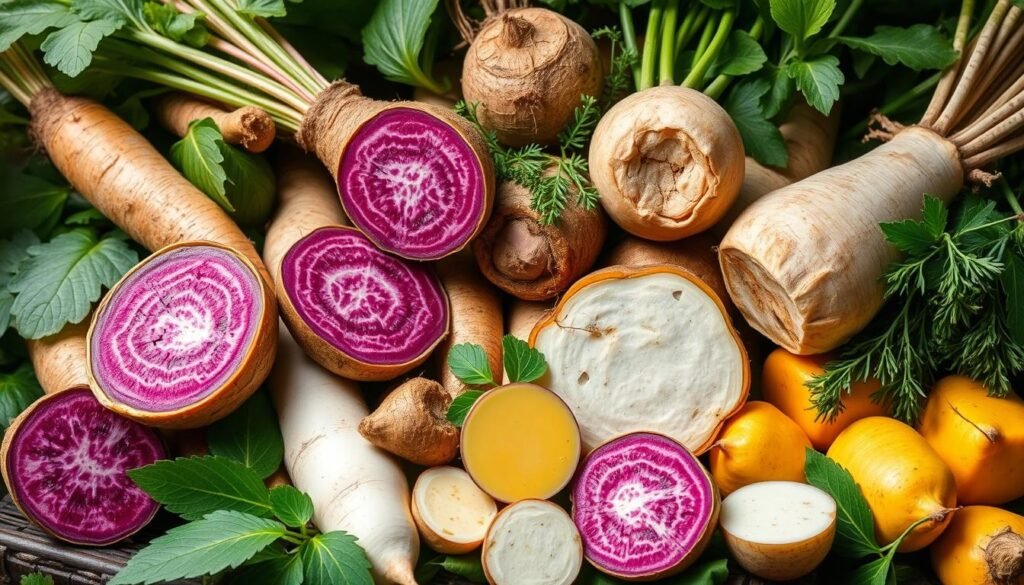
With so many yam types and health benefits, adding yams to our diets is a tasty way to improve health. Each yam variety adds something special to our meals and gives us important nutrients for well-being.
Modern Yam Processing Methods
Exploring modern yam processing shows a big difference from old ways. New tech improves how we make yam products and keeps them nutritious. Old methods were good, but new tech brings big improvements.
Overview of Traditional vs Modern Methods
Old yam processing is manual, involving washing, peeling, and boiling. While it works, it can lose important nutrients. New methods use advanced tech like supercritical fluid extraction. This keeps more nutrients in yam products.
Impact on Nutritional Value
Yam is full of good stuff, like carbs and vitamins. But old ways can lose these. New methods help keep these nutrients, making yam flour better for us.
Here’s a quick look at the difference:
| Aspect | Traditional Methods | Modern Methods |
|---|---|---|
| Processing Steps | Manual washing, peeling, boiling | Automated cleaning, enzymatic processing |
| Nutrient Retention | Variable, often reduced | Enhanced, minimise loss |
| Efficiency | Labour-intensive, time-consuming | High yield, quick processing |
| Final Product | Basic yam flour | Rich in nutrients, varied products |
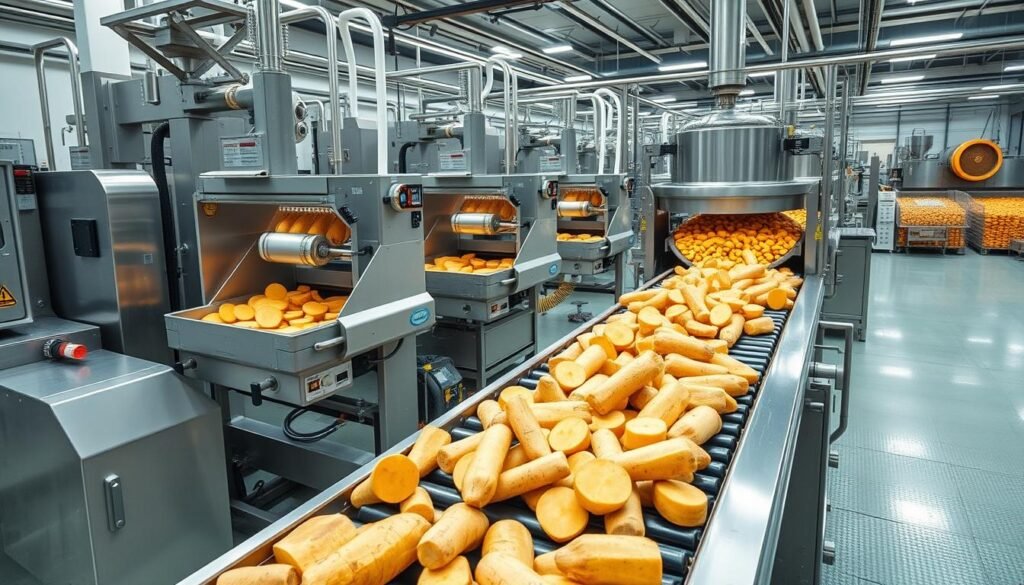
Advanced Yam Processing Equipment
In the modern yam processing sector, advanced equipment is key to better efficiency. New innovations focus on improving washing, peeling, and cutting yams. These advancements make operations smoother and more sustainable.
Innovations in Machinery
New machinery for yam processing brings exciting technologies. Automated peeling and washing systems cut down on time. Now, machines can do several tasks at once, boosting productivity and quality.
Benefits of Using Advanced Equipment
Advanced yam processing equipment brings many benefits. These include:
- Increased Efficiency: Automation speeds up processing, leading to more output.
- Reduced Labour Costs: With fewer tasks, less staff is needed, saving on labour costs.
- Improved Product Quality: Precise processing means better products, meeting high consumer standards.
- Sustainability: Modern machines use less energy and produce less waste, supporting eco-friendly practices.
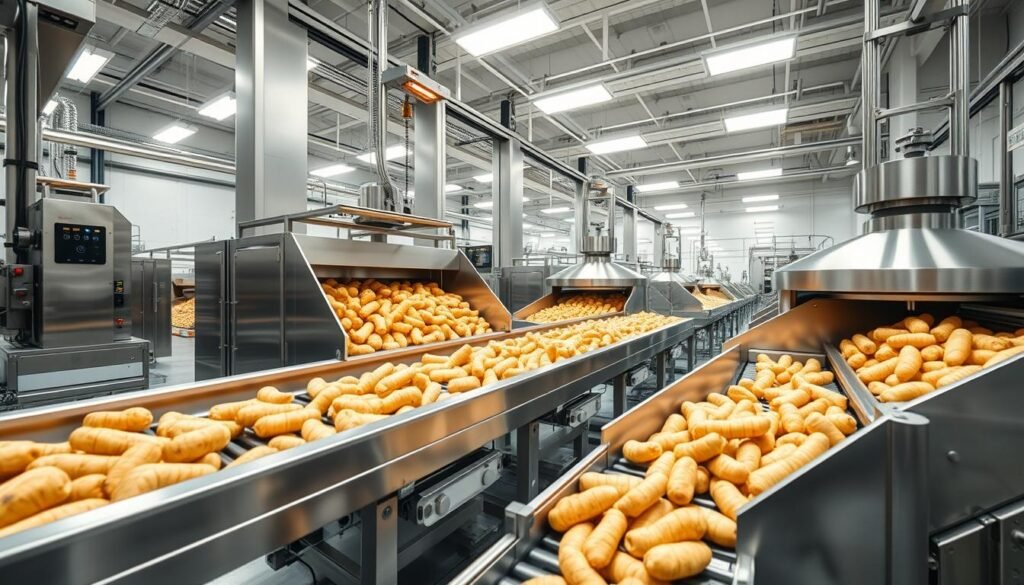
| Equipment Type | Functionality | Benefits |
|---|---|---|
| Automated Peeler | Peeling yams | Speed and consistency in peeling |
| Washing System | Cleaning yams prior to processing | Reduces contaminants and improves quality |
| Cutter | Cutting yams into desired sizes | Ensures uniformity in sizes for cooking or further processing |
| Dryer | Removing moisture from yam products | Extends shelf life and enhances texture |
Efficient Yam Flour Production
We understand the importance of making yam flour efficiently. This process turns yams into a valuable ingredient. It starts from harvesting to processing. In West Africa, especially in Nigeria, yam production has grown a lot, reaching over 70 million metric tonnes a year.
Turning yam into flour meets nutritional needs and meets demand for healthy flour. In Nigeria, the demand for yam flour is about 200,000 tonnes a year. But, the supply is still short. This shows we need better ways to make yam flour.
Our research shows that yam processors are about 85% efficient. This is good, given the challenges they face. High costs, poor facilities, and bad weather are big problems.
Yam flour production can be very profitable. A well-run unit can make over N2,226,000 a month. This means over N26,712,000 a year. This profit could lead to better technology and growth in the industry.
Efficient yam flour production helps local economies. It creates jobs and ensures food security. Yam is full of nutrients, so making flour better is key for feeding more people.
Innovative Yam Processing Techniques
The yam industry has seen big changes with new ways to process yams. These new methods help get more yams and keep them better quality. They also make sure yams are good for us and the planet.
Extraction Technologies
New extraction technologies are key to getting more from yams. They use the latest tech to keep nutrients in yams. Some of these include:
- Enzymatic extraction
- Cold pressing
- Solvent extraction
Each method has its own benefits. For example, enzymatic extraction gets more yams and keeps them nutritious. This is better than older ways.
Enzymatic vs Traditional Methods
Enzymatic methods are different from old ways. Old methods can lose a lot and might not keep yams healthy. But, new methods like enzymatic extraction save more and keep yams fresh.
Using new tech like gamma irradiation helps yams last longer. This means they can stay good for up to six months. Storing them at the right temperature also keeps them fresh for cooking and eating.
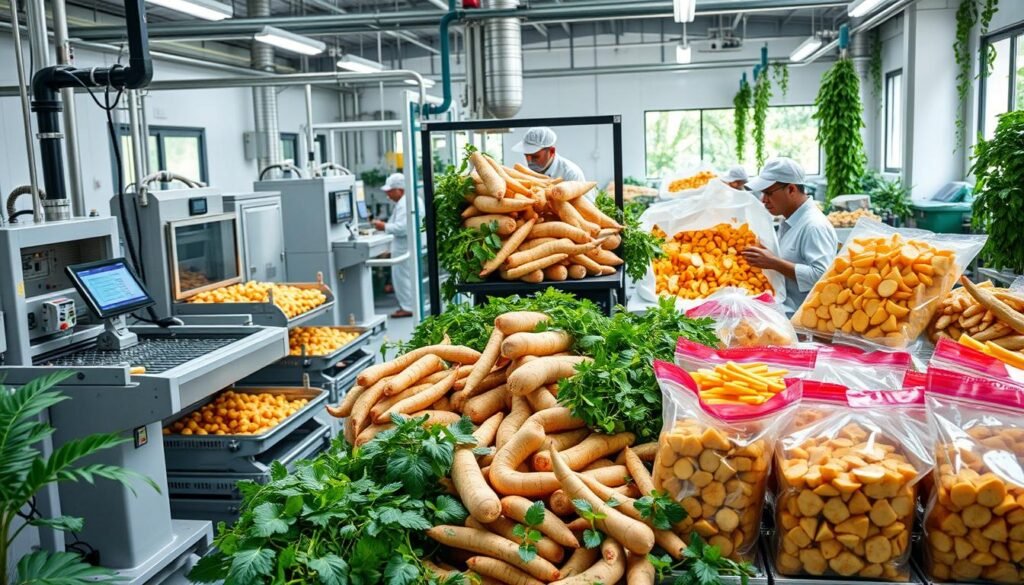
| Processing Method | Key Benefits | Challenges |
|---|---|---|
| Enzymatic Extraction | Higher yields; Nutrient retention | Cost of enzymes |
| Cold Pressing | Preservation of flavours | Lower yield compared to other methods |
| Traditional Methods | Inexpensive | Higher loss rates; Nutrient degradation |
Using new yam processing methods makes the industry better. It helps everyone involved. The future of yam processing looks bright with these new ideas.
Yam Flour Production: The Manufacturing Process
Understanding the yam flour manufacturing process is key for producers and consumers. We follow detailed steps to ensure a quality product. Every stage, from selection to packaging, is carefully managed. Quality control measures are vital to maintain high standards.
Steps in the Yam Flour Making Process
The production of yam flour, like pounded yam flour (elubo), involves several steps:
- Selection: Choosing high-quality yams is the first step.
- Weighing: Accurate measurement is crucial for the right amount of yams.
- Washing: Cleaning the yams removes soil and impurities, showing the importance of quality control.
- Peeling: This step must be done carefully to avoid skin residues.
- Slicing: The yams are cut into smaller pieces for even cooking.
- Parboiling: This process softens the yams, making them easier to dry and grind.
- Drying: Proper drying is vital to achieve the desired powder quality.
- Milling: The dried yam is ground to produce fine flour.
- Packaging: Finally, the flour is sealed in hygienic conditions to maintain its integrity.
Quality Control Measures
Stringent quality control measures are essential throughout the yam flour manufacturing process. Here are some key practices:
- Regular inspections of raw yams to ensure they meet quality standards.
- Monitoring moisture content during drying to prevent spoilage.
- Testing for the presence of contaminants in the final product.
- Utilising advanced equipment to enhance processing efficiency and product quality.
By following these measures, manufacturers can meet the national demand for yam flour. Nigeria alone demands over 300,000 tonnes annually. This ensures success in a competitive marketplace.
| Stage of Production | Description | Quality Control Focus |
|---|---|---|
| Selection | Choose high-quality yams for processing | Inspect for freshness and uniformity |
| Washing | Remove dirt and impurities | Ensure thorough cleaning process |
| Drying | Reduce moisture content for grinding | Monitor humidity levels |
| Milling | Grind dried yams into fine flour | Check fineness and consistency of flour |
| Packaging | Seal yam flour in hygienic packages | Test for seal integrity |
Yam Processing Innovation for Sustainability
In today’s world, it’s crucial to adopt sustainable practices in yam farming. Innovations in yam processing aim to boost efficiency and cut down on environmental harm. These advancements are changing the yam industry, making it more eco-friendly and economically sound.
Sustainable Practices in Yam Farming
Sustainable yam farming aims to increase yields while protecting the environment. Organic farming methods are being used to improve ecosystem health and open up new market opportunities for farmers. The YIIFSWA II project is a great example, investing $12 million in a commercial seed yam system to enhance productivity.
- Yam minisett techniques can produce up to 20 yams from one seed yam.
- Switching to organic farming costs about $500,000 initially but can bring in around $100,000 annually.
- Local maize varieties yield about 1.4 tonnes/ha, while patented varieties yield 1.6 tonnes/ha, showing the need for systemic innovation in agriculture.
Environmental Impact of Yam Processing
As we focus on yam processing innovation, we must consider the environmental impact. Reducing waste is key to preventing environmental harm.
| Impact Factor | Traditional Methods | Innovative Practices |
|---|---|---|
| Waste Generation | High – Significant post-harvest losses | Low – Utilisation of by-products minimizes waste |
| Pesticide Use | Chlorpyrifos and harmful substances | Safer alternatives and organic options |
| Soil Health | Degradation due to chemical overuse | Improved nutrients through organic practices |
| Harvest Efficiency | Labour-intensive and time-consuming | Mechanised processing that reduces time and enhances cleanliness |
Innovations in yam processing address economic challenges and help restore ecological balance in farming. Adopting sustainable practices in yam farming is essential to ensure this vital crop’s future.
Conclusion
The growth in yam processing technology is changing the game for the industry. New methods are making production faster and yam products better. For example, yam flour in places like Cameroon is more popular than ever.
Yam is a key food in many areas, and projects like in Ikanje III village are making a big difference. They help fight poverty, create jobs, and boost income.
More people are caring about their health, making yam a big deal in the food world. We’ve seen how new ways of processing yam, like extrusion cooking, can help. These methods reduce waste and make yam easier to digest.
Places like Bafoussam are showing how yam can be better for us. It’s full of carbs and low in fat, which is great for our health.
In short, using new yam processing tech is key for a better future. We need to keep investing in modern tools and methods. This will make yam products better and help farmers live better lives.
Let’s keep pushing for these advancements. We want a strong and growing yam industry for everyone’s benefit.
FAQ
What are the benefits of modern yam processing technologies?
Modern yam processing technologies, like supercritical fluid extraction and enzymatic methods, boost both yield and nutritional quality. They keep bioactive compounds intact, making yam flour healthier than traditional methods.
How do yams contribute to food security?
Yams are a key food in many countries, especially in Nigeria. They are crucial for the economy and food security. Their nutritional value and versatility support diverse diets and local farming.
What types of yam are commonly cultivated?
Many types of yam are grown worldwide, like D. rotundata (white yam) and D. alata (water yam). Each variety has its own uses in cooking. Knowing these helps choose the right yam for different dishes.
How is yam flour produced efficiently?
The yam flour making process includes harvesting, washing, drying, and grinding. Advanced equipment makes this process more efficient and improves product quality. This meets the growing demand for healthy flour alternatives.
What are the health benefits of consuming yams?
Yams are packed with vitamins C and B6, potassium, and fibre. These nutrients help with gut health, digestion, and overall wellness. Adding yams to our diets can be very beneficial.
What are the key innovations in yam processing?
New advancements include automated yam processing equipment for tasks like washing and peeling. These innovations boost efficiency and keep product quality high. This is key for making competitive yam products.
Why are sustainable practices important in yam processing?
Sustainable practices in yam farming and processing lessen environmental harm and waste. Using by-products and organic farming methods help the ecosystem and local communities. This promotes a sustainable food system.
Can you recommend any specific machinery for yam processing?
Yes, we suggest the Li An machinery Root Veg Washing Peeling machine. It greatly improves processing efficiency, cuts labour costs, and ensures better yam product quality. This enhances yam flour manufacturing processes.
Source Links
- Exploring Shifts in Yam Production Trends Along Nigeria’s Southern Region – https://digitalcommons.subr.edu/cgi/viewcontent.cgi?article=1020&context=osp_facpubs
- Indigenous Food Yam Cultivation and Livelihood Practices in Cross River State, Nigeria – https://www.mdpi.com/2673-4060/4/2/20
- Microsoft Word – (8)14-2-10-2063-for layout editing.doc – https://cigrjournal.org/index.php/Ejounral/article/download/2063/1609/5941
- Effect of Some Processing Variables on the Quality Attributes of Yam Flour – https://www.academia.edu/6054112/Effect_of_Some_Processing_Variables_on_the_Quality_Attributes_of_Yam_Flour
- The Dioscorea Genus (Yam)—An Appraisal of Nutritional and Therapeutic Potentials – https://pmc.ncbi.nlm.nih.gov/articles/PMC7555206/
- The antinutritional and vitamin composition of high‐quality yam flour as affected by yam specie, pretreatment, and drying method – https://pmc.ncbi.nlm.nih.gov/articles/PMC6261217/
- State of the Art of Yam Production – https://www.intechopen.com/chapters/83160
- PDF – https://pub.abuad.edu.ng/Open_Access_Research_Projects_of_Universities_-_Batch_2/CHEMICAL ENGINEERING/THE_PRODUCTION_OF_YAM_FLOUR.pdf
- Variation in the Physical and Functional Properties of Yam (Dioscorea spp.) Flour Produced by Different Processing Techniques – https://www.mdpi.com/2304-8158/10/6/1341
- METHODS OF PROCESSING YAM – https://www.researchs.com.ng/project-preview.php?topic=METHODS OF PROCESSING YAM&id=10318
- Key Steps for Setting Up a Yam Processing Facility – https://www.openpr.com/news/3792577/key-steps-for-setting-up-a-yam-processing-facility
- Cassava flour processing plant – Cassava processing machinery – https://cassavamachinery.wordpress.com/category/cassava-flour-processing-plant/
- Journal of Humanities 2020 JHSSCA (Read-Only – https://journal.funaab.edu.ng/index.php/JHSSCA/article/view/2124/1693
- How To Start Yam Flour Production Business In Nigeria – Ogidi Olu Farms – https://farms.trwconsult.com/how-to-start-yam-flour-production-business-in-nigeria/
- PDF – https://resdojournals.com/index.php/jbeo/article/download/182/417/850
- Prevention of post-harvest food losses … – Root and tuber storage – Processing of cereals (other than rice) – Small-scale rice milling – https://www.fao.org/4/x0039e/x0039e06.htm
- Microsoft Word – jeas_0712_727.doc – http://www.arpnjournals.com/jeas/research_papers/rp_2012/jeas_0712_727.pdf
- The Future of Yam Farming in Nigeria – https://republic.com.ng/october-november-2022/food-security-in-nigeria/
- Yam Farming Business Plan – https://businessplan-templates.com/products/yam-farming-business-plan
- Microsoft Word – WCE 2015 Corrected Camera Ready – https://www.iaeng.org/publication/WCE2015/WCE2015_pp984-988.pdf
- Yam Production & Transformation – https://www.linkedin.com/pulse/yam-production-transformation-nyasa-benyela-clinton
- PDF – https://cigrjournal.org/index.php/Ejounral/article/download/2063/1576/0

